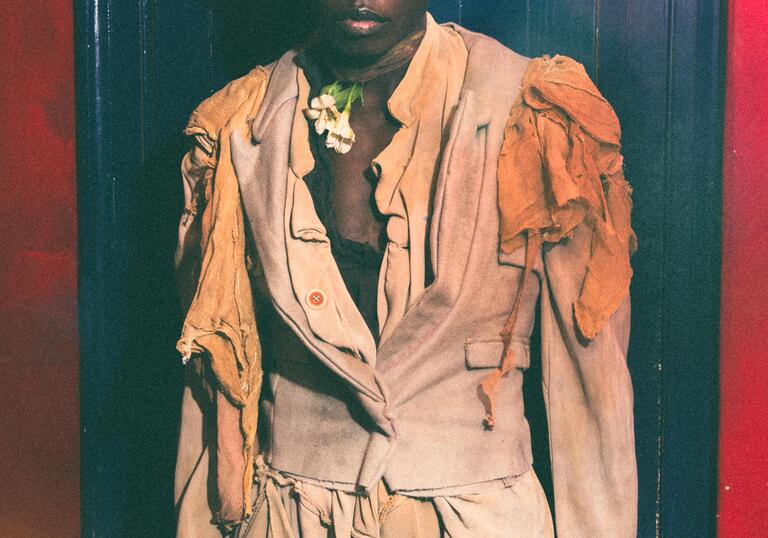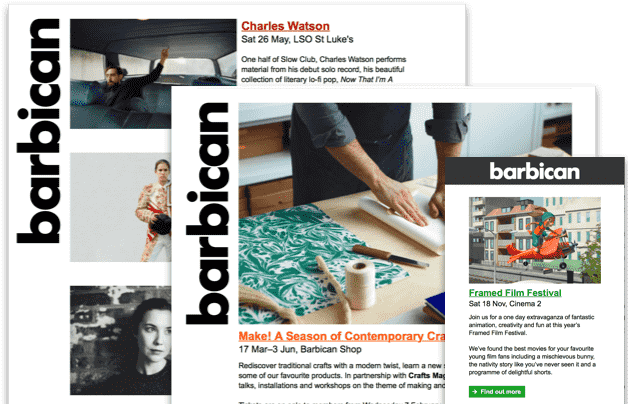Press room
Dirty Looks

From scuffed trainers to ‘bogcore’ and dresses buried underground, contemporary fashion has long embraced its dirty side. But what does this desire for decay tell us about ourselves and the state of fashion?
Opening in September 2025, the Barbican presents Dirty Looks: Desire and Decay in Fashion, an adventurous new exhibition exploring how contemporary fashion has harnessed the rebellious, romantic and regenerative potentials of dirt and decay. Uniting over 60 iconic fashion houses and emerging designers from across Europe, Asia, Africa and the Americas, this major exhibition traces fashion’s enduring fascination with ‘dirty’ aesthetics – from their emergence in the West as symbols of transgression and rebellion, to their evolution into radical forms of craft that question global consumption habits and redefine ideas of modernity, beauty and luxury.
First seen on the runway in the 1980s and championed by designers like Vivienne Westwood and Malcolm McLaren, the aesthetics of mud emerged as a subversive challenge to traditional notions of luxury, class and refinement. Around the same time, the work of Issey Miyake, Rei Kawakubo and Yohji Yamamoto introduced challenges to Western notions of beauty and perfection, instead embracing aesthetics which denoted principles of transience, patina and humility, linked to wabi-sabi philosophies.
In 1993, Hussein Chalayan’s influential graduate collection The Tangent Flows featured garments buried with iron filings in his friend’s London backyard. The rusted dresses expanded the notion of garments as living, organic beings which, like humans, are of the earth and return to the earth in a cycle of ruination and renewal. Today, while distressed clothing no longer carries the same shock factor, a new generation of emerging designers continues to revisit ideas of dirt and decay for their symbolic power – using them as tools to visualise renewal, resistance and new desirable futures for fashion.
Bringing together over a hundred looks from the past half-century, Dirty Looks considers the multifarious ways in which these ideas continue to re-surface, from a preoccupation with landscapes such as the bog, and the obsession with trompe l’oeil ruination and decay, to a new, more spiritual connection to the soil. Taking a broad view of what we label as dirt, the exhibition considers the subversive potential of fashion that confronts us with the “dirtiness” of our own bodies, as well as fashion’s own waste streams. Examining the influence of colonial attitudes and celebrating indigenous perspectives from a variety of places, it also demonstrates what alternative practices – from upcycled materials and regenerated textiles to radical, repurposed deadstock – could offer the industry.
Grouped thematically, these concepts are expanded upon by a series of designer highlights in the upper galleries and original commissions by a new generation of emerging designers in the lower galleries. These emerging designers – including Paolo Carzana, Alice Potts, Michaela Stark, Solitude Studios, Elena Velez and Yaz XL – seek not only to reflect the deepening crises of our time – including environmental degradation – but also to visualise a paradise regained through practices related to folklore, neo-paganism and a celebration of queer and sex-positive communities. At the forefront of artistic experimentation, they touch the transient, romantic and modern qualities at the heart of fashion.
The exhibition design sees the distinctive spaces of the Barbican Art Gallery transformed by Studio Dennis Vanderbroeck – known for its performative and cutting-edge designs for fashion shows and theatre – in a radical reimagining of the ways in which fashion is displayed. Drawing from fashion’s obsession with the illusion of wear and decay, the design will create a tension between the smooth, white spaces of the gallery and intentionally ‘destroyed’ surface treatments.
Shanay Jhaveri, Head of Visual Arts, Barbican, said: “Dirty Looks signals the Barbican’s bold return to fashion as a vital strand of our visual arts programming – one that recognises fashion not only as a form of artistic expression, but also as a lens through which to examine cultural, environmental and political urgencies. This exhibition brings together a remarkable breadth of global designers who are radically reshaping what fashion can mean and do today. With its focus on decay, renewal and the aesthetics of imperfection, Dirty Looks invites us to reconsider beauty, value and the regenerative power of making in a world in flux.”
Highlights of the exhibition include:
- An installation of buried, oxidised garments by Hussein Chalayan, including looks first presented in his 1993 graduate collection The Tangent Flows. The practice of burial, which involves covering clothes with iron filings and submerging them in the soil for several months, has returned over the course of his influential career in fashion. His notion of ‘future archaeology’ symbolises the life cycles of fashion, whilst poetically reflecting on time, transience, rebirth and regeneration.
- A site-specific installation of three looks from Ma Ke’s handmade collection Wuyong/The Earth (2006-07), transforming discarded materials including wood, linen, plastic and tarpaulin using ancient crafts practiced by women in China’s rural regions.
- A newly commissioned film and display by American designer Elena Velez featuring works from her Spring/Summer 2024 collection The Longhouse, which culminated in a mud-wrestle finale.
- Bubu Ogisi’s recent creations for IAMISIGO, a Nigerian fashion label using natural materials as an act of repairing connections to the land that were severed by colonialism.
- London-based designer Robert Wun’s four couture gowns from the collections Time (AW 2023) and Fear (SS 2023), including a wine-stained evening gown and burned yellow ensemble in silk, which elevate ideas of ephemerality and transience to reflect Wun’s spiritual vision.
- A bespoke tableau of Paolo Carzana’s three-season narrative Trilogy of Hope (2024-25), featuring handcrafted, naturally dyed garments made from organic and repurposed materials.
- Solitude Studio’s use of cloth submerged in bogs in their collections, referencing the use of Denmark’s bogs as a site of fertility and good luck offerings in the Iron Age. During this ‘sacrificial’ process the fabric is not only dyed by the soil but partially consumed by microorganisms within the bog.
Eight years since the Barbican’s last major-scale fashion exhibition, Dirty Looks marks the beginning of a new era of fashion programming, building on the success of previous exhibitions including The House of Viktor & Rolf (2008), Future Beauty: 30 Years of Japanese Fashion (2010), The Fashion World of Jean Paul Gaultier (2014) and The Vulgar (2017). This strand of programming, led by Barbican Art Gallery curator Karen Van Godtsenhoven, focuses on fashion as an interdisciplinary and ground-breaking artistic practice, reflecting the changing landscape of fashion today and showcasing futures in which fashion can be harnessed as a positive creative force for its makers, wearers, lovers and our natural environment.
Featured designers in Dirty Looks include: Acne Studios, Miguel Adrover, Ahluwalia, JW Anderson, Balenciaga, Matty Bovan, BUZIGAHILL, Paolo Carzana, Hussein Chalayan, Piero D’Angelo, Giles Deacon, Diesel, Christian Dior , Phoebe English, Hodakova, IAMISIGO, JORDANLUCA, Comme des Garçons, Dilara Findikoglu, Shelley Fox, Jean Paul Gaultier, Ivan Hunga Garcia, Andrew Groves, Nina Hollein, Ayumi Kajiwara, Ma Ke, Ronald van der Kemp, Manon Kündig, Issey Miyake, Helmut Lang, Maison Margiela, Malcolm McLaren, Alexander McQueen, Hamish Morrow, Yuima Nakazato, Louis Gabriel Nouchi, Rick Owens, Carol Christian Poell, Alice Potts, Paco Rabanne, Zandra Rhodes, Marine Serre, Michaela Stark, Moschino, Solitude Studios, SR Studio L.A. C.A. by Sterling Ruby, Olivier Theyskens, TRASHY Clothing, Tom Van der Borght, Elena Velez, Viktor&Rolf, VIN + OMI, Junya Watanabe, Vivienne Westwood, Yodea-Marquel Williams, Robert Wun, XULY.Bët, Yohji Yamamoto, and Yaz XL.
Dirty Looks: Desire and Decay in Fashion
Barbican Art Gallery
Thu 25 Sep 2025—Sun 25 Jan 2026
Press Preview: Wednesday 24 September, 10am – 1pm
@barbicancentre
Lauren Hare, Rees & Co: [email protected]/+44(0) 2031378776
Abigail Francis, Communications Manager: [email protected]/+44(0) 2038341287
Saffron Brown Davis, Communications Assistant : [email protected]/+44(0) 203 834 1136
